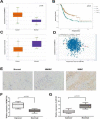MicroRNA-186 suppresses cell proliferation and metastasis in bladder cancer
- PMID: 37092087
- PMCID: PMC10117455
- DOI: 10.4314/ahs.v22i4.8
MicroRNA-186 suppresses cell proliferation and metastasis in bladder cancer
Abstract
Purpose: Bladder cancer (BCa) is a common malignancy in the urinary system. This study aims to explore the role of miR-186 in BCa tumorigenesis.
Methods: The expression of miR-186 and ADAMTS12 in clinical BCa tissues and cell lines was detected. BCa cell lines T24, 5637 and EJ were used to transfect miR-186 mimics or inhibitors. Luciferase reporter gene detection confirmed the correlation between miR-186 and ADAMTS12. MTT method and flow cytometry were used to detect cell viability and apoptosis. Cell migration and invasion ability was detected by transwell assay. The protein level of ADAMTS12, β-catenin, GSK-3β and p-GSK-3β was determined using western blot analysis.
Results: MiR-186 was negatively correlated with the expression of ADAMTS12 in BCa tissues. Further research confirmed that ADAMTS12 is the direct target of miR-186. In addition, overexpression of miR-186 down-regulated the expression of ADAMTS12, inhibiting cell viability and apoptosis, while knockout of miR-186 led to the opposite result. miR-186 also inhibits the phosphorylation of GSK-3 β and β-catenin without changing the total GSK-3β level. Our study shows that miR-186 has a negative regulatory effect on the expression of ADAMTS12 in clinical specimens and in vitro. miR-186 can inhibit the proliferation and invasion of BCa cells.
Conclusions: miR-186 has the potential to be used as a biomarker in the early detection of BCa.
Keywords: ADAMTS12; bladder cancer; metastasis biomarker; miR-186; proliferation.
© 2022 Liang JF et al.
Conflict of interest statement
All authors have no conflicts of interest or financial ties to disclose.
Figures




Similar articles
-
Target inhibition on GSK-3β by miR-9 to modulate proliferation and apoptosis of bladder cancer cells.Eur Rev Med Pharmacol Sci. 2018 May;22(10):3018-3026. doi: 10.26355/eurrev_201805_15059. Eur Rev Med Pharmacol Sci. 2018. Retraction in: Eur Rev Med Pharmacol Sci. 2020 Oct;24(20):10301. doi: 10.26355/eurrev_202010_23351. PMID: 29863246 Retracted.
-
MiR-155 affects proliferation and apoptosis of bladder cancer cells by regulating GSK-3β/β-catenin pathway.Eur Rev Med Pharmacol Sci. 2019 Jul;23(13):5682-5690. doi: 10.26355/eurrev_201907_18305. Eur Rev Med Pharmacol Sci. 2019. Retraction in: Eur Rev Med Pharmacol Sci. 2020 Dec;24(23):11990. doi: 10.26355/eurrev_202012_23976. PMID: 31298320 Retracted.
-
miR-30a Serves as a Tumor Suppressor for Hepatocellular Carcinoma by Downregulating ADAMTS14.Clin Lab. 2022 May 1;68(5). doi: 10.7754/Clin.Lab.2021.210819. Clin Lab. 2022. PMID: 35536085
-
MiR-155 affects renal carcinoma cell proliferation, invasion and apoptosis through regulating GSK-3β/β-catenin signaling pathway.Eur Rev Med Pharmacol Sci. 2017 Nov;21(22):5034-5041. doi: 10.26355/eurrev_201711_13813. Eur Rev Med Pharmacol Sci. 2017. Retraction in: Eur Rev Med Pharmacol Sci. 2020 Aug;24(16):8239. doi: 10.26355/eurrev_202008_22579. PMID: 29228417 Retracted.
-
MicroRNA-3619-5p suppresses bladder carcinoma progression by directly targeting β-catenin and CDK2 and activating p21.Cell Death Dis. 2018 Sep 20;9(10):960. doi: 10.1038/s41419-018-0986-y. Cell Death Dis. 2018. PMID: 30237499 Free PMC article.
Cited by
-
Unveiling ADAMTS12: A key driver of bladder cancer progression via COL3A1-Mediated activation of the FAK/PI3K/AKT signaling pathway.J Biol Chem. 2025 Feb;301(2):108155. doi: 10.1016/j.jbc.2025.108155. Epub 2025 Jan 4. J Biol Chem. 2025. PMID: 39761856 Free PMC article.
-
Editorial: Non-communicable diseases; sexual reproductive issues; infectious diseases and health systems challenges.Afr Health Sci. 2022 Dec;22(4):i-v. doi: 10.4314/ahs.v22i4.1. Afr Health Sci. 2022. PMID: 37092096 Free PMC article. No abstract available.
-
Bladder cancer: non-coding RNAs and exosomal non-coding RNAs.Funct Integr Genomics. 2024 Aug 31;24(5):147. doi: 10.1007/s10142-024-01433-9. Funct Integr Genomics. 2024. PMID: 39217254 Review.
-
miR-329b-5p Affects Sheep Intestinal Epithelial Cells against Escherichia coli F17 Infection.Vet Sci. 2024 May 8;11(5):206. doi: 10.3390/vetsci11050206. Vet Sci. 2024. PMID: 38787178 Free PMC article.
References
-
- Sanli O, Dobruch J, Knowles MA, Burger M, Alemozaffar M, Nielsen ME, et al. Bladder cancer. Nat Rev Dis Primers. 2017;3:17022. - PubMed
-
- Ferlay J, Colombet M, Soerjomataram I, Mathers C, Parkin DM, Pineros M, et al. Estimating the global cancer incidence and mortality in 2018: GLOBOCAN sources and methods. Int J Cancer. 2019;144(8):1941–1953. - PubMed
-
- Herr HW. High-risk superficial bladder cancer: transurethral resection alone in selected patients with T1 tumor. Semin Urol Oncol. 1997;15(3):142–146. - PubMed
MeSH terms
Substances
LinkOut - more resources
Full Text Sources
Medical
Molecular Biology Databases
Miscellaneous
